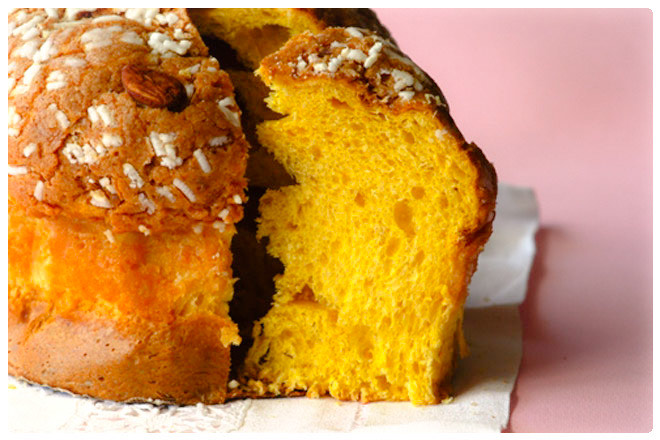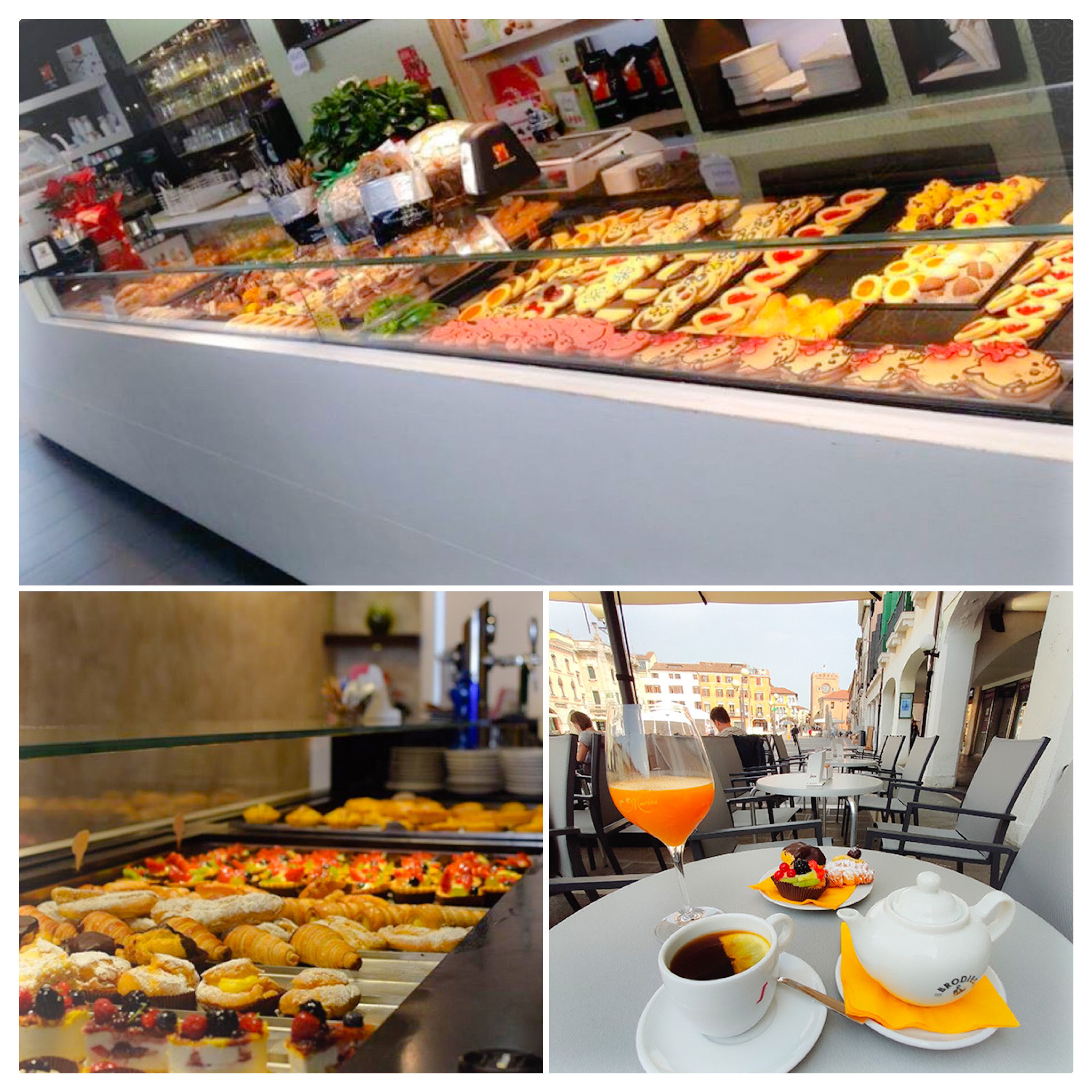
There is no feast or anniversary that does not even carry an ancient culinary tradition. Even in Venice celebrations and gastronomy always go hand in hand, and Christmas is under the sign of fugassa, a soft and very tasty sweet in its simplicity. From the singular history this fugassin, as the Venetians call it, born as a poor Easter cake, then consumed throughout the winter period, especially at Christmas due to its resemblance to the most famous Pandoro and Panettone. But don't get confused, the Venetian fugassa has a strong identity.
The maker apparently was a Treviso bakeries of the fifteenth century, which in the period of Lent tried to enrich its bread dough with eggs, sugar and butter. The inspiration came from the Far East, as is often the case with the ancient Venetian recipes: Veneto very soon experienced Christianity with which it came into contact thanks to its proximity to Alexandria in Egypt during mercantile expeditions. And from the East came the knowledge of sweet bread, sugar and the use of eggs as a symbol of spring and the rebirth of life in the sign of the Resurrection of Christ. The baker's intuition led to an extraordinary product, characterized by softness and sweetness. But the costs of these added ingredients were quite high and therefore there was no possibility to do it often. It became so sweet typical of Easter days consumed above all by the poorest populations who found delight in the consumption of such a simple but very tasty product. Little time passed and the fugassa also became a silent and sugary witness of the unions of love: prepared to celebrate the engagements it became a casket for the ring that the future groom gave to his beloved. Covered with granules of sugar, instead, it was inevitable at wedding banquets so as to become a symbol of new unions: “beato ti che ti ga ancora la fugassa col suchero sopra” (lucky you that you still have the fugassa covered with sugar) in the popular language it was a metaphor for a recently celebrated marriage.
Over the centuries the dessert was enriched with spices and oriental fragrances, reaching the tables of the nobles and the laboratories of the skilled Scaler of the Serenissima: it was precisely the confectioners, in the centuries to come, to structure the recipes differently, making it a more refined dessert without compromising its feature of simplicity. Times change and so the dessert is enriched with a glaze prepared with egg whites and sugar and decorated with almonds, which brings it closer to the Christmas tradition: simple as a pandoro and similar to a panettone devoid of candied fruit, but lighter thanks to reduced percentage of butter present, because innovation is good, but tradition cannot be touched!
The recipe, a few ingredients, a long time
The lightness of the preparation is given by the complex and long leavening: 4 different leavenings with a 3-hour pause between them. It is therefore a very complex dessert to prepare and which also requires good manual skills. Do you want to try your hand at the business? Here is the recipe:
Ingredients for lievitino:
• 15 g brewer's yeast
• 90 gr. Warm milk
• 90 gr flour
Ingredients for the dough:
• 3 medium eggs
• 150 g butter (50 for the first dough, 50 for the second dough and 50 more to add at the end of the process)
• 600 gr flour (350 for the first dough and 250 for the second)
• 190 gr sugar (110 for the first mixture and 80 for the second)
• 30 gr marsala
• about 40 drops of cedar extract (this aroma is important and should not be replaced with another one, the doses should be adjusted according to the type of extract)
• 5 gr salt
• vanilla as required
Ingredients for the icing:
• 100 grams of granulated sugar
• 40 grams of almonds
• Egg white enough
Preparation:
step 1: prepare the lievitino by mixing all the ingredients together to create a very soft dough. Leave to rest for about 30 minutes.
step 2: work 2 eggs with 50 g of butter, 350 g of flour, 110 g of sugar and then add the lievitino. Work this dough in a planetary mixer or by hand for about 10 minutes, or the time necessary for it to become smooth and well elastic. Allow the hours needed to double its volume to rise in a warm environment.
step 3: work a new dough with an egg, 50 grams of butter, 250 grams of flour, 80 grams of sugar and the aromas. After working it well for a few minutes add it to the previous mixture. Then add the salt and work for a long time: it must be a smooth and elastic dough, if it appears grainy continue to work it. After the dough is smooth, add the last 50 grams of butter and work again until completely absorbed. At this point make the second rising, from 4 to 6 hours in a warm environment, at a temperature between 25 and 27 degrees.
step 4: If the rising temperature has been favorable you will find yourself a dough more than doubled. Make a light syrup with 2 tablespoons of sugar and a little water. Dissolve on a low heat and let cool, then brush your fugassa. If you prefer you can make a glaze with mixing sugar and almonds and then adding freshly beaten egg white. Let it rest for about 30 minutes in the fridge and then sprinkle your fugassa.
Bake in a preheated static oven at 170 degrees for 45/50 minutes: the times are indicative because it depends on your oven. For a perfect cooking, rely on the inevitable toothpick test.
But do you feel the fragrance that invades your home?
Antica Pasticceria Marini, from 1890 the realm of fugassa

Let's face it, playing fugassa at home is a very difficult operation. So why not choose to taste it in pastry? Much simpler, isn't it ?!
Not far from Venice, on the mainland, I recommend you try this dessert, and not only, at the Antica Pasticceria Marini in Mestre: located in the heart of Piazza Erminio Ferretto is the oldest confectionery laboratory in the Mestre city, founded in 1890.
The ideal place to spend pleasant moments of the day with friends and relatives, and be pampered with their specialties, from breakfast to an aperitif, passing by snacks and snacks.
There is a wide range of Marini confectionery products: excellent leavened products such as croissants and croissants; the refined pastry with mignon for all tastes, single portions and cakes for every occasion; tasty savory preparations to accompany the inevitable spritz. Certainly there is no lack of traditional Venetian desserts, such as the dry pastry of spiced pastry: taste bussolà, zetri and pevarini, all of which are delicious. Then you get to the very soft fugassa, which you can find only from Marini almost all year round.
Because at Marini sweetness and professionalism are at home, all year round!
The Antica Pasticceria Marini is in Piazza Erminio Ferretto 41, Mestre
Open every day from 7.30am to 8.30pm










Lascia un commento